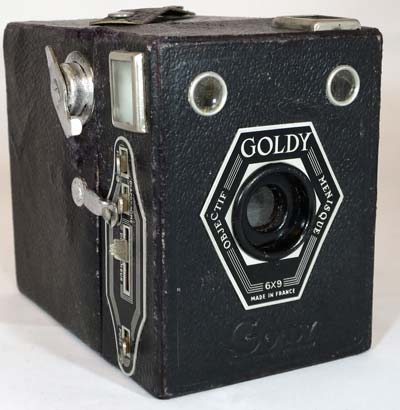Goldstein Goldy
Specification

| Manufacturer | : | Goldstein |
|---|---|---|
| Produced | : | 1947 |
| Classification | : | Medium Format |
| Body Type | : | Box |
| Construction | : | Cardboard, metal, wood |
| Film Type | : | 120 |
| Film Width | : | 62mm |
| Image Size | : | 2¼" x 3¼" |
| No. of Images | : | 8 |
| Lens Type | : | Meniscus |
| Focal Length | : | 105mm |
| Focus Type | : | Fixed |
| Focal Range | : | 10ft - Inf. |
| Aperture Type | : | fixed |
| Apertures | : | f/16, f/22 * |
| Shutter Type | : | Rotary |
| Shutter Speeds | : | T/I*(1/50s) |
| Size (w x h x d) | : | 80 x 105 x 118 mm |
| Weight | : | 400g |
| * Educated Guess | ||
Art Deco Credentials
![]()
![]()
Acceptable: Modest and restricted
- Produced after the main Art Deco period.
- Coffin shaped front plate.
- Quad line decoration on front plate.
- Decorative control plate.
- Five line decoration on control plate.
Description
The Goldy was made in France after World War II. It was a popular camera and a huge success. The box is made of cardboard but the film transport system is made from pressed steel. It was originality manufactured in several colors and was available in black, red, green, blue, havana, burgundy and white. It took 8 2¼" x 3¼" (6cm x 9cm) pictures on popular 120 film.
There were many variations of this camera, some supporting flash. The covering varied including canvas, small grain and large grain leatherette. The handle varied too with both straight or slant-wise and cardboard or leather.
This model has a T/I shutter. The time mode (POSE) is selected by pulling out a tab on the side. The shutter is operated by a lever (DECLENCHEUR) on the side control panel. Another tab (FILTRE) is used to select a yellow filter. It has two aperture settings, actuated by another tab (DIAPHRAGME) on the side.
It has two waist level viewfinders for portrait and landscape. Each is constructed with a lens, mirror and matte screen for viewing. Film advance is by turn-key and red window.
There are no tripod sockets.
How to Use
This camera takes 120 film which is easily available. It has a two aperture settings of probably f/16 (tab in) and f/22 (tab out). The speed is probably 1/50s. I haven't found documentation to verify the speed and apertures, and the example I have is jammed. I have therefore made an educated guess for these values.
The yellow filter is often used to produce more contrast between clouds and blue sky when B/W film is being used. It will reduce exposure by about 1 stop.
With a shutter speed of only 1/50 sec, make sure you brace the camera against your body or something solid and press the shutter smoothly to avoid camera shake.
If you don't want to bother with an exposure meter, follow the guide shown. It is based on the 'Sunny 16' rule. Film is so forgiving and will produce acceptable results even when over-exposed by 2 or 3 stops or under-exposed by 1 stop.
The table shown assumes the shutter speed is about 1/50s.
The table also assumes that the sun is at least 30 degrees above the horizon - that's 10am - 5pm on a summers day in the UK.
Remember that the exposure guide in the manual may not be helpful as it is based on the use of old film with a low ISO value.
Using ISO 100/125 film - shutter speed 1/50s
| Weather Conditions | Shadow Detail | Aperture | Exposure |
|---|---|---|---|
 Sunny SunnySnow/Sand | Dark with sharp edges | f/22 | +1 Stop Overexposed Acceptable |
 Sunny Sunny | Distinct | f/22 | Good |
 Slight Overcast Slight Overcast | Soft around edges | f/16 | Good |
 Overcast Overcast | Barely visible | f/16 | -1 Stop Underexposed Acceptable |
 Heavy Overcast Heavy Overcast | None | f/16 | -2 Stops Underexposed Not Acceptable |
 Open Shade Open Shade/Sunset | None | f/16 | -3 Stops Underexposed Not Acceptable |